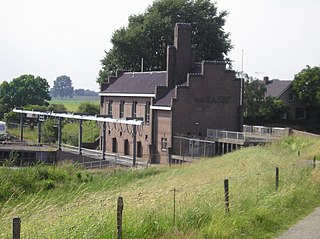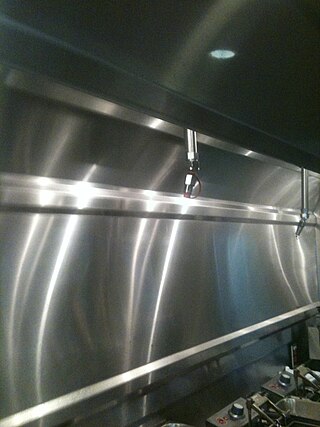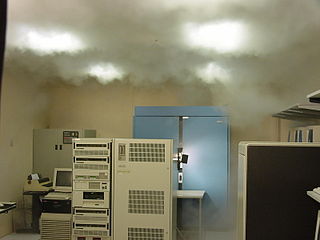
A fire hose is a high-pressure hose that carries water or other fire retardant to a fire to extinguish it. Outdoors, it attaches either to a fire engine, fire hydrant, or a portable fire pump. Indoors, it can permanently attach to a building's standpipe or plumbing system.

A fire sprinkler system is an active fire protection method, consisting of a water supply system, providing adequate pressure and flowrate to a water distribution piping system, onto which fire sprinklers are connected. Although historically only used in factories and large commercial buildings, systems for homes and small buildings are now available at a cost-effective price. Fire sprinkler systems are extensively used worldwide, with over 40 million sprinkler heads fitted each year. Even though Fire Sprinkler Systems are a Life Saving System and are not designed to protect the building, 96% of buildings that had fires and were completely protected by fire sprinkler systems were controlled by the fire sprinklers alone.

A fire hydrant, waterplug, or firecock (archaic) is a connection point by which firefighters can tap into a water supply. It is a component of active fire protection. Underground fire hydrants have been used in Europe and Asia since at least the 18th century. Above-ground pillar-type hydrants are a 19th-century invention.

Pumping stations, also called pumphouses in situations such as drilled wells and drinking water, are facilities containing pumps and equipment for pumping fluids from one place to another. They are used for a variety of infrastructure systems, such as the supply of water to canals, the drainage of low-lying land, and the removal of sewage to processing sites. A pumping station is an integral part of a pumped-storage hydroelectricity installation.

In North America, a standpipe is a type of rigid water piping which is built into multi-story buildings in a vertical position, or into bridges in a horizontal position, to which fire hoses can be connected, allowing manual application of water to the fire. Within the context of a building or bridge, a standpipe serves the same purpose as a fire hydrant.
Firefighting jargon includes a diverse lexicon of both common and idiosyncratic terms. One problem that exists in trying to create a list such as this is that much of the terminology used by a particular department is specifically defined in their particular standing operating procedures, such that two departments may have completely different terms for the same thing. For example, depending on whom one asks, a safety team may be referred to as a standby, a RIT or RIG or RIC, or a FAST. Furthermore, a department may change a definition within its SOP, such that one year it may be RIT, and the next RIG or RIC.

A fire sprinkler or sprinkler head is the component of a fire sprinkler system that discharges water when the effects of a fire have been detected, such as when a predetermined temperature has been exceeded. Fire sprinklers are extensively used worldwide, with over 40 million sprinkler heads fitted each year. In buildings protected by properly designed and maintained fire sprinklers, over 99% of fires were controlled by fire sprinklers alone.
This is a glossary of firefighting equipment.

An irrigation sprinkler is a device used to irrigate (water) agricultural crops, lawns, landscapes, golf courses, and other areas. They are also used for cooling and for the control of airborne dust. Sprinkler irrigation is the method of applying water in a controlled manner in way similar to rainfall. The water is distributed through a network that may consist of pumps, valves, pipes, and sprinklers.

A fire pump usually refers to a pressure-increasing component of the water supply for fixed-place fire suppression systems such as fire sprinklers, standpipes, and foam systems. Fire pumps are also a critical component integrated into fire trucks and fire boats, and serve a similar purpose boosting water supplies for firefighting hose operations. Fire pumps are used to increase the pressure of water sourced from a municipal underground water supply piping network, or a static supply. A fire pump is a centrifugal- or positive displacement- pump that has been tested and listed by a third-party testing and listing agency, such as UL or FM Global specifically for fire service use. The main standard that governs fire pump fixed-place installations in North America is the National Fire Protection Association's NFPA 20 Standard for the Installation of Stationary Fire Pumps for Fire Protection.

Fire suppression systems are used to extinguish, control, or in some cases, entirely prevent fires from spreading or occurring. Fire suppression systems have an incredibly large variety of applications, and as such, there are many different types of suppression systems for different applications being used today. Of these, there are some that are still in use but are no longer legal to manufacture and produce.
Active fire protection (AFP) is an integral part of fire protection. AFP is characterized by items and/or systems, which require a certain amount of motion and response in order to work, contrary to passive fire protection.

A fitting or adapter is used in pipe systems to connect straight sections of pipe or tube, adapt to different sizes or shapes, and for other purposes such as regulating fluid flow. These fittings are used in plumbing to manipulate the conveyance of water, gas, or liquid waste in domestic or commercial environments, within a system of pipes or tubes.
Firefighting is the act of extinguishing destructive fires. A firefighter fights these fires with the intent to prevent destruction of life, property and the environment. Firefighting is a highly technical profession, which requires years of training and education in order to become proficient. A fire can rapidly spread and endanger many lives; however, with modern firefighting techniques, catastrophe can usually be avoided. To help prevent fires from starting, a firefighter's duties include public education and conducting fire inspections. Because firefighters are often the first responders to victims in critical conditions, firefighters often also provide basic life support as emergency medical technicians or advanced life support as licensed paramedics. Firefighters make up one of the major emergency services, along with the emergency medical service, the police, and many others.

Automatic fire suppression systems control and extinguish fires without human intervention. Examples of automatic systems include fire sprinkler system, gaseous fire suppression, and condensed aerosol fire suppression. When fires are extinguished in the early stages loss of life is minimal since 93% of all fire-related deaths occur once the fire has progressed beyond the early stages.

Sprinkler fitting is an occupation consisting of the installing, testing, inspecting, and certifying of automatic fire suppression systems in all types of structures. Sprinkler systems installed by sprinkler fitters can include the underground supply as well as integrated overhead piping systems and standpipes. The fire suppression piping may contain water, air, antifreeze, gas or chemicals as in a hood system, or a mixture producing fire retardant foam.
Water transportation and distribution networks require hydraulic calculations to determination the flowrate and pressure characteristics at one or several consumption points and the water supply flowrate and pressures needed to meet the design requirements.

The Evansville Standpipe is a historic water tower located in Evansville, Wisconsin. The 80-ft tall steel tower was built in 1901 by the Chicago Bridge & Iron Company, as part of the development of the local water supply system, spurred on by a devastating fire in 1896 that destroyed a large section of downtown Evansville. It was added to the National Register of Historic Places in 2008.

A water distribution system is a part of water supply network with components that carry potable water from a centralized treatment plant or wells to consumers to satisfy residential, commercial, industrial and fire fighting requirements.














